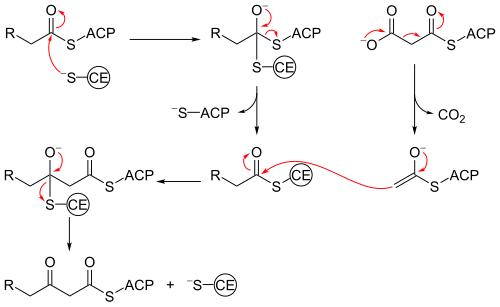Beta-ketoacyl-ACP synthase
| 3-oxoacyl-ACP synthase, mitochondrial | |||||||||||||||||
|---|---|---|---|---|---|---|---|---|---|---|---|---|---|---|---|---|---|
| Identifiers | |||||||||||||||||
| Symbol | OXSM | ||||||||||||||||
SCOP2 | 1kas / SCOPe / SUPFAM | ||||||||||||||||
In molecular biology, Beta-ketoacyl-ACP synthase  Beta-ketoacyl-ACP conserved enzyme that is found in almost all life on earth as a domain in fatty acid synthase (FAS). FAS exists in two types, aptly named type I and II. In animals, fungi, and lower eukaryotes, Beta-ketoacyl-ACP synthases make up one of the catalytic domains of larger multifunctional proteins (Type I), whereas in most prokaryotes as well as in plastids and mitochondria, Beta-ketoacyl-ACP synthases are separate protein chains that usually form dimers (Type II).[1][2]
Beta-ketoacyl-ACP synthase III, perhaps the most well known of this family of enzymes, catalyzes a Claisen condensation between acetyl CoA and malonyl ACP. The image below reveals how CoA fits in the active site as a substrate of synthase III.
 Beta-ketoacyl-ACP synthases I and II only catalyze acyl-ACP reactions with malonyl ACP. Synthases I and II are capable of producing long-chain acyl-ACPs. Both are efficient up to acyl-ACPs with a 14 carbon chain, at which point synthase II is the more efficient choice for further carbon additions. Type I FAS catalyzes all the reactions necessary to create palmitic acid, which is a necessary function in animals for metabolic processes, one of which includes the formation of sphingosines.[1] Beta-ketoacyl-ACP synthase is found as a component of a number of enzymatic systems, including Emericella nidulans multifunctional protein Wa, which is involved in the biosynthesis of conidial green pigment; Rhizobium nodulation protein nodE, which probably acts as a beta-ketoacyl synthase in the synthesis of the nodulation Nod factor fatty acyl chain; and yeast mitochondrial protein CEM1.
Structure Beta-ketoacyl synthase contains two binding and catalysis[4]
In animals and in prokaryotes, beta-ketoacyl-ACP synthase is a domain on type I FAS, which is a large enzyme complex that has multiple domains to catalyze multiple different reactions. Analogously, beta-ketoacyl-ACP synthase in plants is found in type II FAS; note that synthases in hydrophobic pocket.[4] Certain experiments have also suggested the presence of "fatty acid transport tunnels" within the beta-ketoacyl-ACP synthase domain that lead to one of many "fatty acid cavities", which essentially acts as the active site.[7]
MechanismBeta-ketoacyl-synthase’s tetrahedral transition state.[1] The driving force of the reaction comes from the decarboxylation of malonyl ACP; the energy captured in that bond technically comes from ATP, which is what is initially used to carboxylate acetyl CoA to malonyl CoA.[9]
 Biological functionThe main function of beta-ketoacyl-ACP synthase is to produce fatty acids of various lengths for use by the organism. These uses include energy storage and creation of cell membranes. Fatty acids can also be used to synthesize prostaglandins, phospholipids, and vitamins, among many other things. Further, palmitic acid, which is created by the beta-ketoacyl-synthases on type I FAS, is used in a number of biological capacities. It is a precursor of both stearic and palmitoleic acids. Palmitoleic can subsequently be used to create a number of other fatty acids.[10] Palmitic acid is also used to synthesize sphingosines, which play a role in cell membranes.[1] Clinical significanceThe different types of beta-ketoacyl-ACP synthases in type II FAS are called FabB, FabF, and FabH synthases. FabH catalyzes the quintessential ketoacyl synthase reaction with malonyl ACP and acetyl CoA. FabB and FabF catalyze other related reactions. Given that their function is necessary for proper biological function surrounding pathway may thus be a leverage point in disrupting bacterial proliferation.[11] By studying Yersinia pestis, which causes bubonic, pneumonic, and septicaemic plagues, researchers have shown that FabB, FabF, and FabH can theoretically all be inhibited by the same drug due to similarities in their binding sites. However, such a drug has not yet been developed.[12] Cerulenin, a molecule that appears to inhibit by mimicking the "condensation transition state" can only inhibit B or F, but not H. Another molecule, thiolactomycin, which mimics malonyl ACP in the active site, can only inhibit FabB.[13] Lastly, platensimycin also has possible antibiotic use due to its inhibition of FabF.[14]
These types of drugs are highly relevant. For example, Y. pestis was the main agent in the outbreak of infection by Y. pestis. If it is not treated within 24 hours, it normally results in death. Furthermore, there is worry that it can now be used as a possible biological warfare weapon.[12]
Unfortunately, many drugs that target prokaryotic beta-ketoacyl-synthases carry many side effects. Given the similarities between prokaryotic ketoacyl synthases and mitochondrial ones, these types of drugs tend to unintentionally also act upon mitochondrial synthases, leading to many biological consequences for humans.[2] Industrial applicationsRecent efforts in freezing point. Using E. coli as the organism of choice, engineers have replaced the endogenous FabH domain on FAS, which favors unbranched chains, with FabH versions that favor branching due to their high substrate specificity for branched acyl-ACPs.[15]
See also
References
External links
Further reading
| |||||||||||||||||
